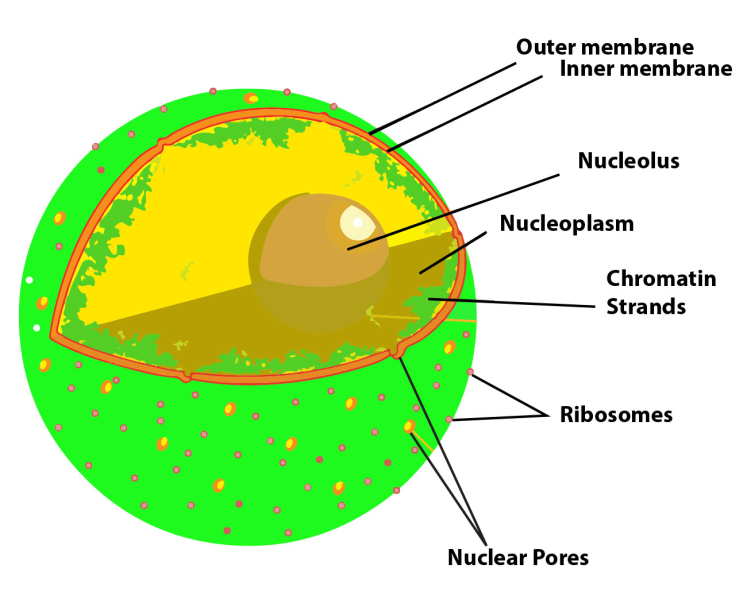
Non-membranous organelle is
(A) Chloroplast
(B) Nucleolus
(C) Centriole
(D) Both B and C
Answer
564.6k+ views
Hint: The organelle which is Non-membranous is present inside the nucleus in the eukaryotes and the other structure which is non-membranous is an organelle composed of mainly a protein called tubulin.
Complete answer:
Non-membranous organelle is both Nucleolus and the Centriole. Non-membranous organelles are the types of organelles that are not surrounded by a membrane such as a nucleolus and Centrosome, Membranous organelles are surrounded by a membrane such as the Endoplasmic reticulum and chloroplast.


So, the correct answer is ‘Both B and C’.
Additional Information:
- The nucleolus is the distinct structure present within the nucleus of eukaryotic cells. Primarily, it functions in alteration of transfer RNA, assembling the ribosomes, and sensing cellular stress. The nucleolus consists of RNA and proteins, which form around specific chromosomal regions.
- A centriole is a type of organelle that is cylindrical in shape and it is composed mainly of a protein called tubulin. Centrioles are found in most eukaryotic cells. A highly dense material that bound the pair of centrioles and surrounds them is called the pericentriolar material (PCM), which makes up a structure called a centrosome. The main function of centrioles is to supply the aster and the spindle during cellular division, and cilia during interphase.
- Chloroplasts is the organelle that is found in higher plants is generally biconvex or plano- convex shaped. The chloroplast consists of an inner and outer membrane along with it an empty intermediate space in between. Inside the chloroplast are stacks of thylakoids, called grana, also as stroma, the dense fluid inside the chloroplast. These thylakoids contain the chlorophyll that's necessary for the plant to travel through photosynthesis. The space the chlorophyll fills is named the thylakoid space.
Note: Centriole was first discovered by Boveri and Van Beneden in the 1880s. The organelle nucleolus was identified by using bright- field microscopy during the 1830s. In 1966 Max L. Birnstiel and collaborators showed via nucleic acid hybridization experiments that DNA which has nucleoli present in its code for ribosomal RNA.
Complete answer:
Non-membranous organelle is both Nucleolus and the Centriole. Non-membranous organelles are the types of organelles that are not surrounded by a membrane such as a nucleolus and Centrosome, Membranous organelles are surrounded by a membrane such as the Endoplasmic reticulum and chloroplast.


So, the correct answer is ‘Both B and C’.
Additional Information:
- The nucleolus is the distinct structure present within the nucleus of eukaryotic cells. Primarily, it functions in alteration of transfer RNA, assembling the ribosomes, and sensing cellular stress. The nucleolus consists of RNA and proteins, which form around specific chromosomal regions.
- A centriole is a type of organelle that is cylindrical in shape and it is composed mainly of a protein called tubulin. Centrioles are found in most eukaryotic cells. A highly dense material that bound the pair of centrioles and surrounds them is called the pericentriolar material (PCM), which makes up a structure called a centrosome. The main function of centrioles is to supply the aster and the spindle during cellular division, and cilia during interphase.
- Chloroplasts is the organelle that is found in higher plants is generally biconvex or plano- convex shaped. The chloroplast consists of an inner and outer membrane along with it an empty intermediate space in between. Inside the chloroplast are stacks of thylakoids, called grana, also as stroma, the dense fluid inside the chloroplast. These thylakoids contain the chlorophyll that's necessary for the plant to travel through photosynthesis. The space the chlorophyll fills is named the thylakoid space.
Note: Centriole was first discovered by Boveri and Van Beneden in the 1880s. The organelle nucleolus was identified by using bright- field microscopy during the 1830s. In 1966 Max L. Birnstiel and collaborators showed via nucleic acid hybridization experiments that DNA which has nucleoli present in its code for ribosomal RNA.
Recently Updated Pages
The number of solutions in x in 02pi for which sqrt class 12 maths CBSE

Write any two methods of preparation of phenol Give class 12 chemistry CBSE

Differentiate between action potential and resting class 12 biology CBSE

Two plane mirrors arranged at right angles to each class 12 physics CBSE

Which of the following molecules is are chiral A I class 12 chemistry CBSE

Name different types of neurons and give one function class 12 biology CBSE

Trending doubts
One Metric ton is equal to kg A 10000 B 1000 C 100 class 11 physics CBSE

Explain zero factorial class 11 maths CBSE

What is 1s 2s 2p 3s 3p class 11 chemistry CBSE

Discuss the various forms of bacteria class 11 biology CBSE

State the laws of reflection of light

Difference Between Prokaryotic Cells and Eukaryotic Cells




